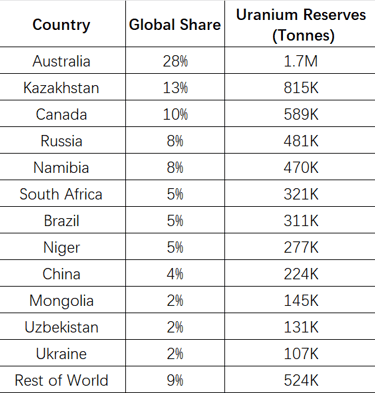Global Uranium Reserves: The Hidden Abundance Powering Nuclear Energy
Xuan-Ce Wang
6/30/20253 min read
Many people believe uranium is rare. This idea comes from its role in nuclear energy and the mystique surrounding radioactive materials. The truth is, uranium is more abundant than gold and silver, yet its distribution across the globe tells a fascinating story of geological fortune and geopolitical significance.
Let's take a closer look at global uranium reserves by country as of 2021. The data comes from the World Nuclear Association, updated in August 2023, revealing some surprising insights about this critical energy resource.
The Big Three: Dominating Global Reserves
Australia, Kazakhstan, and Canada hold over 50% of the world's uranium resources, creating a concentrated supply base for nuclear energy worldwide.
Australia stands out with more than 1.7 million tonnes, representing 28% of the world's total reserves. The country's Olympic Dam mine is not only the largest single deposit of uranium globally but also serves as the fourth-largest copper deposit, showcasing how uranium often occurs alongside other valuable minerals.
Kazakhstan follows with 815,000 tonnes (13% of global reserves), while Canada rounds out the top three with 589,000 tonnes (10% of global reserves). Together, these three nations control just over half of all known uranium reserves.
The Complete Global Picture
Here's the full breakdown of uranium reserves by country:
Note: All figures are rounded. Total global reserves: 6.1M tonnes
Outside the top three, Russia and Namibia each hold about 8% of global reserves, equaling roughly 470,000-481,000 tonnes. South Africa, Brazil, and Niger also contribute significantly with 5% each of the total deposits. China, despite being a major nuclear power, ranks ninth with 4% of global reserves, or about 224,000 tonnes.
The Economics of Uranium Mining
Not all uranium deposits are created equal, and understanding the economics reveals why some countries dominate production despite having smaller reserves.
At Australia's Olympic Dam, uranium is extracted as a byproduct of copper mining, making the operation more economically viable. Similarly, in South Africa, uranium comes from treating ores in gold mining operations. When two or more valuable substances are found together, it can significantly lower extraction costs and increase profit margins.
This co-occurrence of valuable minerals explains why some countries with smaller reserves can be major producers, while others with large reserves may not mine as extensively due to economic constraints.
A Growing Resource Base
It's crucial to understand that these figures reflect known reserves that can be mined economically under current market conditions and technology. The uranium story is far from static – new deposits are discovered regularly, and extraction technology continues to improve.
In fact, known uranium reserves have increased by approximately 25% in the last decade. This growth stems from:
Advanced exploration technology that can identify previously unknown deposits
Improved extraction methods that make previously uneconomical deposits viable
Higher uranium prices that justify exploration in new regions
Enhanced geological understanding of uranium formation and location patterns
Geopolitical Implications
The concentration of uranium reserves in a relatively small number of countries creates interesting geopolitical dynamics. Unlike oil, which is distributed across many regions, uranium's concentration means that nuclear energy programs worldwide depend on relationships with a handful of nations.
This concentration has several implications:
Supply security concerns for countries heavily dependent on nuclear energy
Strategic importance of maintaining good relationships with uranium-rich nations
Potential for supply disruptions due to political instability or trade disputes
Investment opportunities in uranium exploration and mining infrastructure
The Future of Uranium Supply
Understanding uranium reserves is crucial for several reasons. This knowledge helps guide energy policies, investment decisions, and long-term planning for nuclear energy programs. As the world seeks clean energy alternatives to combat climate change, nuclear power's role becomes increasingly important.
The abundance of uranium relative to precious metals suggests that supply constraints are unlikely to limit nuclear energy expansion in the foreseeable future. However, the geographic concentration of reserves means that geopolitical factors will continue to play a significant role in uranium markets.
Looking Ahead: Technology and Geopolitics
Since uranium is more abundant than gold and silver but mainly produced in a few countries, several factors could dramatically affect its supply and the growth of nuclear energy in the coming decades:
Technological Advances:
New extraction methods could make currently uneconomical deposits viable
Advanced reactor designs that use uranium more efficiently
Potential breakthroughs in seawater uranium extraction
Improved recycling technologies for spent nuclear fuel
Geopolitical Shifts:
Trade relationships between uranium-rich and uranium-dependent nations
Political stability in major producing countries
International nuclear cooperation agreements
Sanctions and trade restrictions affecting uranium markets
Market Dynamics:
Growing demand from emerging nuclear programs
Competition between nuclear and renewable energy sources
Investment in new mining operations and infrastructure
Price volatility affecting exploration and production decisions
The future of nuclear energy doesn't depend on uranium scarcity – there's plenty of uranium to power the world for centuries. Instead, it depends on how effectively we can manage the geopolitical, technological, and economic factors that influence uranium supply chains.
As nations worldwide grapple with energy security and climate change, understanding the global distribution of uranium reserves becomes increasingly important for policymakers, investors, and anyone interested in the future of clean energy.
What are your thoughts on uranium's role in future energy systems? How do you think geopolitical factors might shape nuclear energy development? Share your insights in the comments below.










